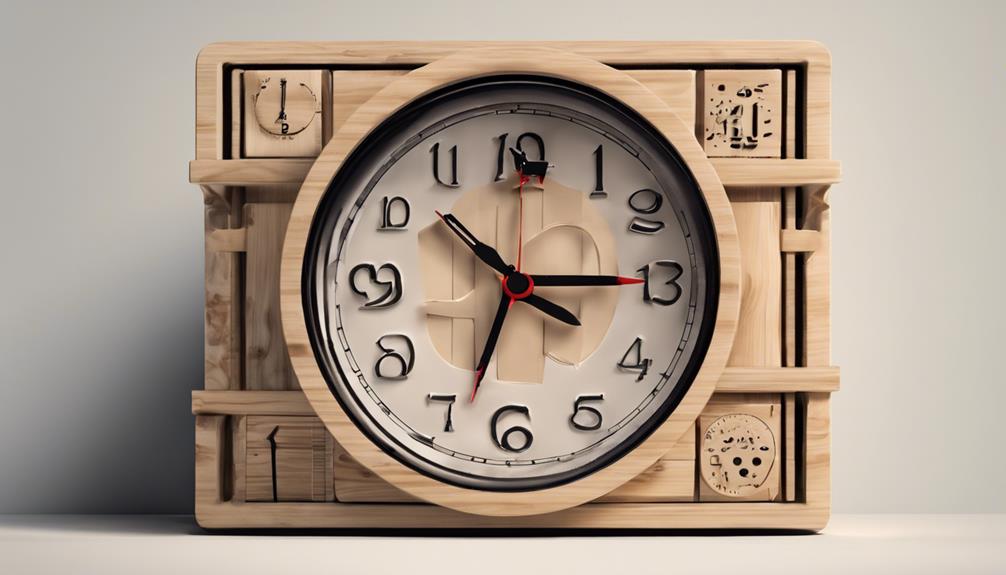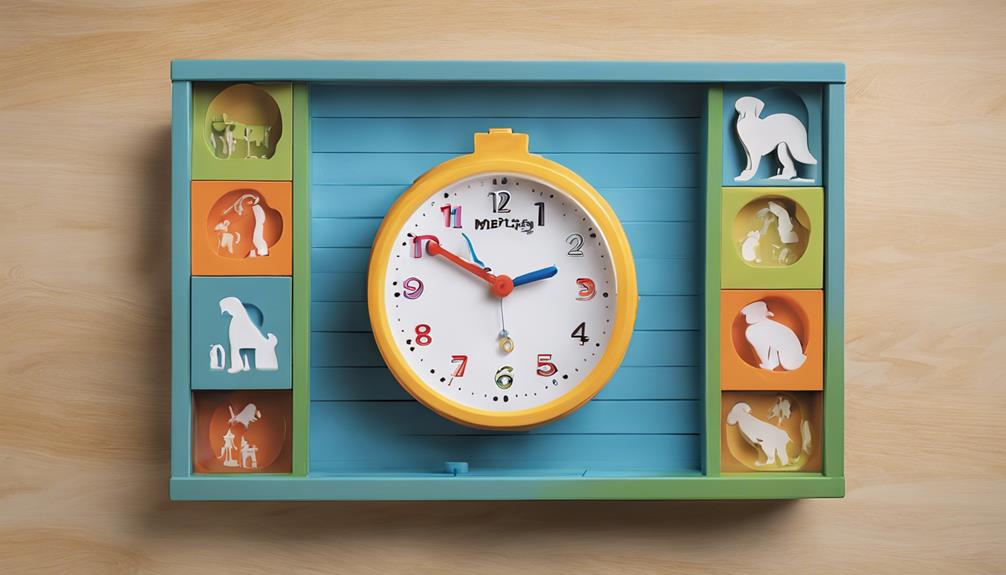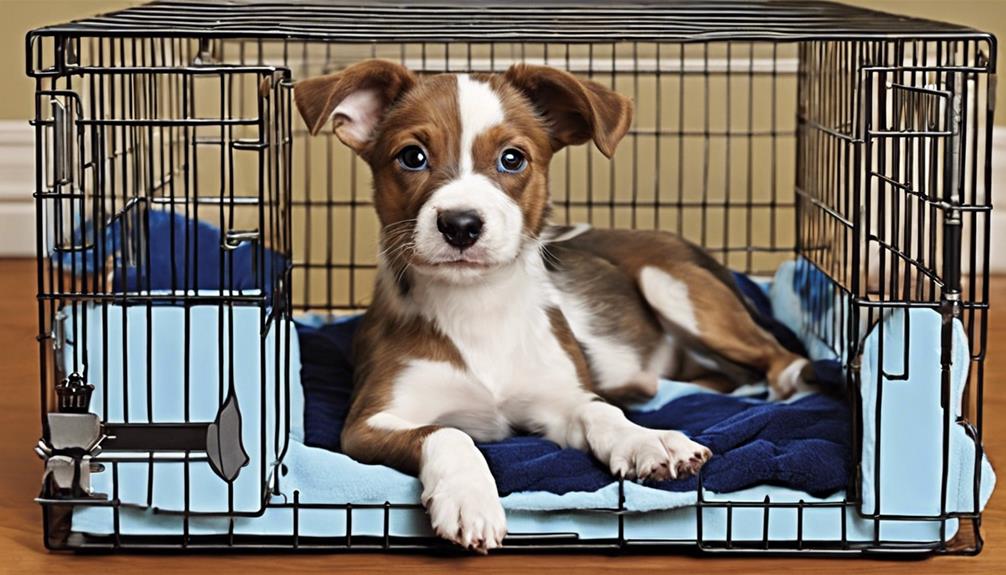When it comes to managing work and puppy responsibilities, having a well-planned crate training program that fits your furry friend’s age and needs is crucial. Be sure to adhere to specific guidelines for crate training based on age, such as restricting crate time for pups under 6 months to 3-4 hours and offering regular potty breaks. Establish a regular schedule, adapt as your dog matures, and emphasize positive reinforcement.
To strike a balance between work and puppy care, integrating technology, short training sessions, and realistic goals is key. Remember, every pup is unique, so customizing the schedule to their individual needs ensures a harmonious routine that fosters successful crate training.
Key Takeaways
- Schedule consistent potty breaks every 2-3 hours.
- Incorporate short play sessions before and after work.
- Utilize technology like cameras to monitor your puppy.
- Provide mental stimulation with interactive toys.
- Ensure a peaceful environment in the crate while you're away.
Age-appropriate Crate Training Guidelines
When starting crate training with your puppy, it's important to think about age-appropriate guidelines to guarantee their comfort and well-being. Puppies have different needs based on their age, especially when it comes to crate training. Young pups under 6 months old shouldn't be crated for more than 3-4 hours to prevent accidents and make sure they're comfortable.
Adjusting the crate training schedule according to the puppy's age is essential. Younger dogs require more frequent potty breaks and naps compared to older dogs. Consistency in feeding time, providing regular potty breaks, and incorporating naps are crucial elements of a successful crate training routine for all age groups.
It's essential to follow a specific routine tailored to different age groups to support effective crate training. By understanding the time, needs, and comfort levels of puppies at various stages, owners can create a routine that fosters a positive crate training experience for their furry companions.
Break Frequency Recommendations

To establish successful crate training, it's important to determine appropriate break frequency based on your dog's age, bladder capacity, and individual needs. For puppies under 6 months old, it's recommended to provide a break every 2-3 hours during crate training sessions. This frequency aligns with their limited bladder capacity and helps prevent accidents inside the crate.
Adult dogs, on the other hand, can typically hold their bladder for longer periods, ranging from 4-6 hours. It's essential to adjust breaks according to your dog's age and bladder capacity, ensuring they can comfortably wait between breaks without discomfort.
When starting crate training, plan for shorter breaks initially and gradually increase the time between breaks as your dog becomes accustomed to the schedule. Consistency in break frequency is key to reinforcing the training routine and fostering successful outcomes in crate training.
Balancing Work and Puppy Care
Balancing work responsibilities with caring for a puppy demands a well-structured routine that prioritizes scheduled potty breaks, feeding times, and consistent crate training sessions. Here are some key strategies to help working owners maintain this balance effectively:
- Incorporate Technology: Utilize cameras or monitors to keep an eye on your puppy while you're away at work, ensuring their well-being and monitoring their behavior.
- Plan Short Training Sessions: Before and after work, engage in brief training sessions to maintain consistency in your puppy's routine and reinforce positive behaviors.
- Utilize Breaks: Make use of lunch breaks or consider hiring a dog walker to provide necessary attention and breaks for your puppy during the workday.
- Set Realistic Expectations: Gradually increase the time your puppy spends alone in the crate to help them adjust to being alone while you're at work, setting achievable goals for both you and your furry companion.
Structured Training Routine Overview

Creating a structured routine for crate training is essential for working owners to establish a consistent and effective training regimen for their puppy. By incorporating key elements such as feeding times, potty breaks, playtime, and socialization into a well-organized schedule, working owners can guarantee their puppy receives the necessary care and training throughout the day. Monitoring the puppy's progress and adjusting the schedule as needed are vital steps in achieving successful crate training. Gradually increasing the time spent in the crate during the workday helps the puppy adjust to longer periods of alone time, promoting independence and confidence.
| Activity | Time |
|---|---|
| Feeding | 7:00 AM & 5:00 PM |
| Potty Breaks | Every 2-3 hours |
| Playtime | Morning & Evening |
| Crate Sessions | Before & After Work |
| Socialization | Weekends |
Ensuring Dogs Well-being During Work
Considering the well-being of your dog while you're at work is crucial for their overall happiness and comfort throughout the day. To guarantee your furry friend stays content and mentally engaged during your absence, here are some key strategies:
- Provide mental stimulation: Incorporate interactive toys and puzzles in the crate to keep your dog's mind active and engaged while you're away.
- Use calming aids: Consider utilizing pheromone diffusers or calming collars to help reduce stress and anxiety levels in your dog while you're at work.
- Offer distractions: Keep your dog occupied by providing frozen stuffed Kongs or long-lasting chews to enjoy while inside the crate.
- Create a peaceful environment: Place the crate in a quiet area free from distractions to promote relaxation and a sense of security for your pet.
Frequently Asked Questions
How Do You Crate Train When You Work Full Time?
When we work full time, crate training involves gradual introduction and strategic potty breaks. We use interactive toys and monitoring devices to keep our puppy engaged and safe. Consistency and routine are key for successful training.
What Is a Good Crate Training Schedule?
Curious about the ideal crate training schedule? We have everything you need. Begin with consistent potty breaks and structured meal times. Slowly extend crate time, engage in play before crating, and incorporate mental stimulation for a joyful pup.
How Many Times a Day Should You Work on Crate Training?
We work on crate training our puppy 2-3 times daily, aiming for 10-15 minute sessions each time. It's important to maintain consistency and adjust based on progress. Short, positive sessions help build a routine and positive associations with the crate.
Can I Get a Puppy if I Work 9 5?
Yes, we can get a puppy while working 9-5 with careful planning. Breaks or a dog walker help meet their needs. Crate training provides structure. Plan potty breaks, playtime, and meals around work hours.
Can I Use the Age-Appropriate Crate Training Schedule for Working Owners?
Yes, you can use a crate training schedule for puppies even if you are a working owner. It’s important to stick to a consistent routine and gradually increase the time your puppy spends in the crate. Providing mental enrichment and exercise before and after crating can help minimize stress and anxiety.
Conclusion
As we navigate the challenges of balancing work and puppy care, remember that crate training is a valuable tool in ensuring our furry friends' well-being.
Like a gentle beacon guiding us through rough waters, a structured routine and break frequency recommendations can help us create a harmonious balance between work and caring for our beloved companions.
Trust in this ultimate crate training schedule to provide stability and comfort for both you and your pup as you journey through the busy days ahead.










